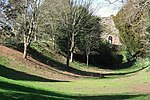St Stephen's Church, Exeter
Church of England church buildings in DevonChurches in ExeterDevon building and structure stubsEnglish church stubsGrade II* listed churches in Devon ... and 2 more
Tourist attractions in ExeterUse British English from December 2017

St Stephen's Church is a small church in the centre of Exeter. It has a Saxon crypt but the first mention of the church is in the Domesday Book. Its location (now near the middle of the High Street) was formerly opposite the medieval guildhall. In July 2012 it reopened following a major renovation which cost £1.5 million.
Excerpt from the Wikipedia article St Stephen's Church, Exeter (License: CC BY-SA 3.0, Authors, Images).St Stephen's Church, Exeter
High Street, Exeter Newtown
Geographical coordinates (GPS) Address External links Nearby Places Show on map
Geographical coordinates (GPS)
| Latitude | Longitude |
|---|---|
| N 50.724 ° | E -3.5298 ° |
Address
St. Stephens Church
High Street
EX4 3LW Exeter, Newtown
England, United Kingdom
Open on Google Maps










